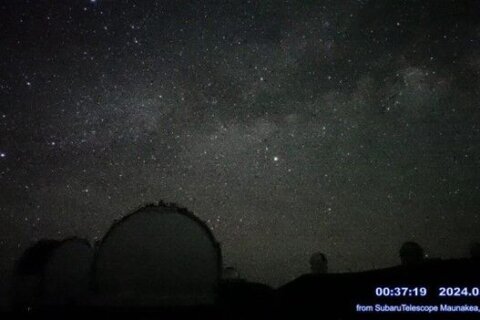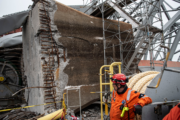April 10, 2019, will be a historic date in the history of science as it was the day humanity saw the first ever image of a supermassive black hole. Get the details from the Jet Propulsion Lab and from the National Science Foundation.
It was just over two years ago that I reported about the undertaking of this project with the Event Horizon Telescope (EHT).
You can appreciate Wednesday’s EHT image even more after viewing two videos and seeing what the parent galaxy, M-87, looks like.
This video shows you where M-87 is in the sky and takes you into the heart of the galaxy to reveal Wednesday’s black hole image.
That zoom video starts with a view of ALMA and zooms in on the heart of M-87, showing successively more detailed observations and culminating in the first direct visual evidence of a supermassive black hole’s shadow.
If you want to experience a breathtaking ride into a supermassive black hole like M-87, go to a dark room with all of the lights off, set your computer’s display to full brightness and full screen and watch this video! It is so stunning, it almost gave me vertigo.
That virtual reality simulation by Jordy Davelaar and colleagues shows a black hole surrounded by luminous matter. This matter disappears into the black hole in a vortex-like way, and the extreme conditions cause it to become a glowing plasma. The light emitted is then deflected and deformed by the powerful gravity of the black hole.
For comparison with the black hole image at the center of M-87, here is what the galaxy looks like to the Hubble Space Telescope. You can clearly see the jet running out away from the galaxy, which is caused by the supermassive black hole.
EHT also took data over a year ago of our Milky Way Galaxy’s own supermassive black hole, Sagittarius A* (Sgr A*). It is a 4.4 million solar mass beast at the center of our galaxy.
I spoke to Peter D. Edmonds, public information officer for the Center for Astrophysics at Harvard-Smithsonian, by phone to ascertain the status of the Sgr A* image. “That’s a good question. The Sgr A* EHT image work is quite complicated and it is ongoing. We currently do not have a release date for that image,” Edmonds said.
Hopefully, one day we will see the image of our own galaxy’s resident supermassive black hole.
When we do, that will be another historic day.
ALSO: Huge space news Wednesday and potentially Thursday — a commercial Israeli spacecraft attempting a moon landing. The moon landing attempt will be broadcast live between 3 and 4 p.m. EDT.
Follow me at Twitter @skyguyinva and my daily blog at www.whatsupthespaceplace.com to keep up with the latest news in astronomy and space exploration. You can email me at skyguyinva@gmail.com.






